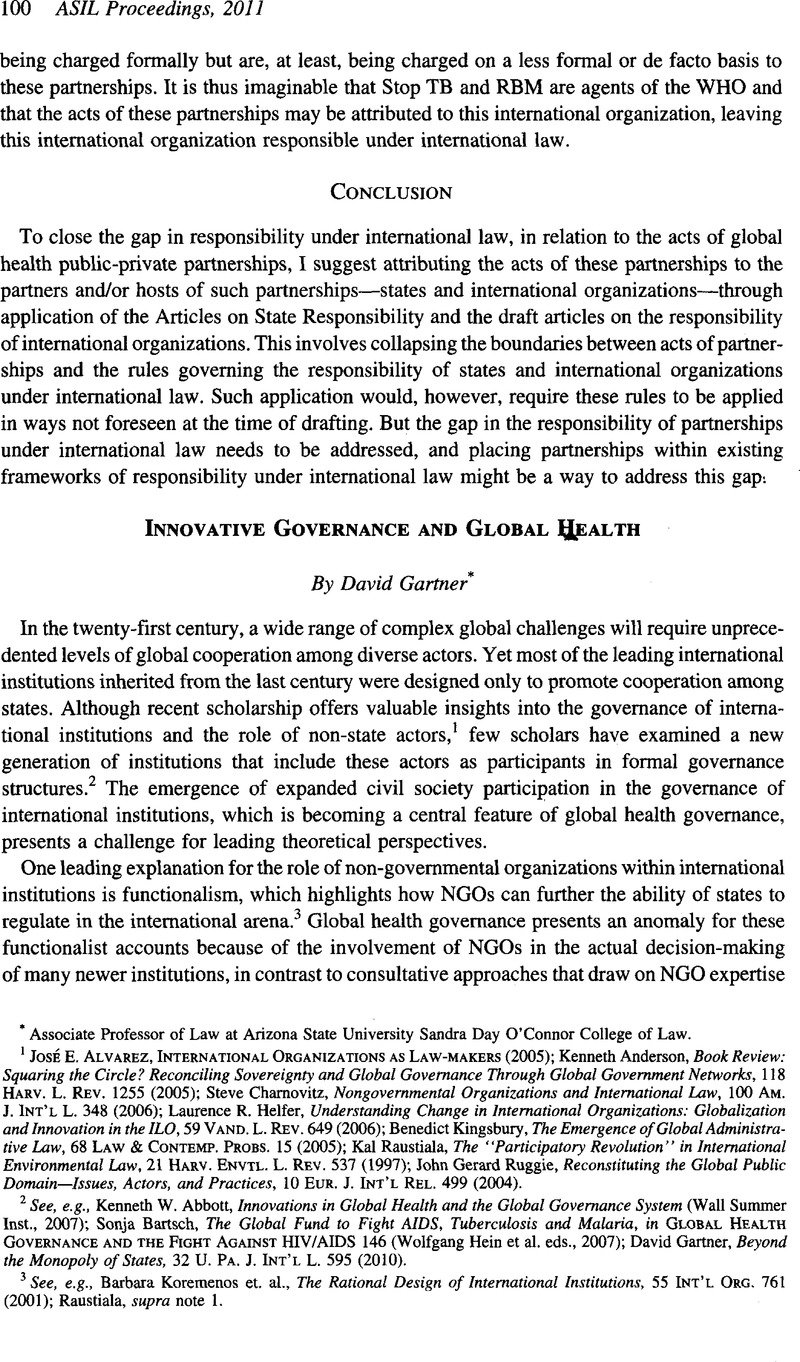No CrossRef data available.
Article contents
Innovative Governance and Global Health
Published online by Cambridge University Press: 28 February 2017
Abstract

- Type
- New Voices I: Global Health, Trade, and Common Resource Regimes
- Information
- Copyright
- Copyright © American Society of International Law 2011
References
1 José E. Alvarez, International Organizations as Law-Makers (2005); Anderson, Kenneth, Book Review: Squaring the Circle ? Reconciling Sovereignty and Global Governance Through Global Government Networks, 118 Harv. L. Rev. 1255 (2005)Google Scholar; Charnovitz, Steve, Nongovernmental Organizations and International Law, 100 Am. J. Int’l L. 348 (2006)CrossRefGoogle Scholar; Heifer, Laurence R., Understanding Change in International Organizations: Globalization and Innovation in the Ilo, 59 Vand. L. Rev. 649 (2006)Google Scholar; Kingsbury, Benedict, The Emergence of Global Administra tive Law, 68 Law & Contemp. Probs. 15 (2005)Google Scholar; Raustiala, Kal, The “Participatory Revolution” in International Environmental Law, 21 Harv. Envtl. L. Rev. 537 (1997)Google Scholar; Ruggie, John Gerard, Reconstituting the Global Public Domain—Issues, Actors, and Practices, 10 Eur. J. Int’l Rel. 499 (2004)Google Scholar.
2 See, e.g., Abbott, Kenneth W., Innovations in Global Health and the Global Governance System (Wall Summer Inst., 2007)Google Scholar; Bartsch, Sonja, The Global Fund to Fight Aids, Tuberculosis and Malaria, in Global Health Governance and the Fight Against HIV/AIDS 146 (Hein, Wolfgang et al. eds., 2007)CrossRefGoogle Scholar; Gartner, David, Beyond the Monopoly of States, 32 U. Pa. J. Int’l L. 595 (2010)Google Scholar.
3 See, e.g., Koremenos, Barbara et. al., The Rational Design of International Institutions, 55 Int’l Org. 761 (2001)Google Scholar; Raustiala, supra note 1.
4 Abbott, Kenneth W. and Gartner, David, Reimagining Participation in International Institutions, 8 Journal of International Law and International Relations (Forthcoming 2012)Google Scholar.
5 Gartner, supra note 2.
6 U.N. Charter art. 71.
7 Adams, Barbara, Ecosoc and Ngos: A Review of the Review, in Civil Society Engaging Multilateral Institutions: At the Crossroads 8, 11 (1999)Google Scholar, available at http://www.fimcivilsociety.org/en/library/FrMFor-uml999.pdf.
8 Constitution of the World Health Organization, Chapter Xvi, Article 71.
9 Governance and Civil Society Involvement in the UN General Assembly, http://www.unaids.org/en/media/unaids/contentassets/documents/programmes/janbeagle/civilsociety/cs_BlL2_gov.pdf.
10 Gavi Alliance, Innovative Partnership, http://www.gavialliance.org/about/in_partnership/index.php (last vis ited Aug. 29, 2010).
11 Id.
12 Bartsch, supra note 2, at 146.
13 Id. at 152.
14 Abbott & Gartner, supra note 4.
15 See, e.g., Pierson, Paul, Increasing Returns, Path Dependence, and the Study of Politics, 94 AM. Pol. Sci. Rev. 251 (2000)CrossRefGoogle Scholar.
16 United Kingdom Department for International Development, Multilateral Aid Review Assessment by Institution, http://www.dfid.gov.uk/About-DFIDAVho-we-work-withMultilateral-agencies/Assessment-by-institution-index/.
17 International Center for Research on Women, Civil Society Participation in Global Fund Governance: What Difference Does it Make: Preliminary Research Findings 2-3 (2004), http://www.theglobal-fund.org/documents/library/studies/position_papers/PP_PS2_full.pdf.




